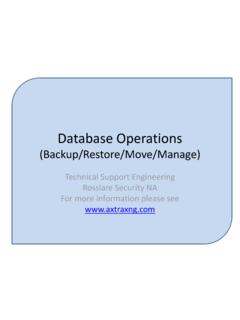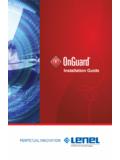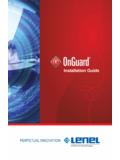Transcription of The Alchemy Database - Atticus Consulting
1 Alchemy Database White Paper Version 7 - 1 - The Alchemy Database An Open and Extensible Architecture for Efficient Management of Unstructured Data Abstract: This paper discusses key concepts regarding the Alchemy Database . The corporate challenge with unstructured data management The Database architecture and data structures Compatibility with industry standards Database storage options Benefits of the Database Information Management Research 6025 South Quebec Street, Suite 260 Englewood, CO 80111 303-689-0022 April 2002 update for Release 7 Alchemy Database White Paper Version 7 - 2 - TABLE OF CONTENTS The Alchemy Database An Open and Extensible Architecture for Efficient Management of Unstructured Data Section 1 Introduction p.
2 3 The Corporate Challenge with Unstructured Data Management The Solution: Alchemy Section 2 Database Architecture p. 4 Client/Server Implementation Reliability Multiple databases Simultaneous Database users Section 3 Data Structures p. 6 B-tree Data Structures Database File Structures Database File Storage Example where documents are not copied to the data container Database updates When additional .DAT and .PRO files are created Database backup and recovery The compound document structure Database performance considerations Query (Read) operations Write operations Section 4 The Database Query Engine p.
3 10 Section 5 Compatibility with Industry Standards p. 11 ODBC SQL interface to Alchemy COM interfaces to data structures WIN32 file system Option to store documents outside the container file Section 6 Database Storage Flexibility p. 12 File Server Hard Disc RAID (Redundant Array of Inexpensive Discs) Workstation Hard Discs CD Writer/Reader CD-ROM Tower CD-ROM/DVD Jukebox Optical Libraries Combination of Devices Section 7 Benefits of the Database Summarized p. 14 Alchemy Database White Paper Version 7 - 3 - 1. Introduction This paper covers the following key concepts regarding the Alchemy Database : The common problem with unstructured data management The Database architecture and data structures Compatibility with industry standards The benefits of the Database summarized The Corporate Challenge with Unstructured Data Management Before explaining the Alchemy Database , the paper will discuss the problems Alchemy was designed to solve.
4 Most of the knowledge and information created by companies resides outside of structured databases or outside the applications that created the data, and are labeled unstructured data . Getting control of this unstructured data is widely recognized as the key to accelerating necessary enterprise operations. The unstructured data at most organizations is typically made up of many different types of files and formats: paper, microfilm, scanned images (TIFFs), computer report files (COLD), Adobe Acrobat PDF files, text files, Microsoft Office documents, color images, video, audio and other binary files. The Internet explosion has also created a new class of unstructured data types that are threatening to overwhelm information management systems: Email, especially with attachments HTML files Relational databases such as Oracle and Microsoft have introduced methods to integrate and manage unstructured data.
5 While it is possible to integrate unstructured data content with a relational Database , these methods are often too complex for many companies to implement, and implementation can require significant computing and programming resources. The Solution: Alchemy Alchemy was introduced in 1994 as a Microsoft Windows software product that enabled companies to efficiently manage, archive and distribute unstructured data, using the new CD recordable technology as the new paradigm for storage. In subsequent product releases, IMR expanded Alchemy to become today s 32-bit Database manager of all unstructured data types utilizing any storage platform compatible with Windows NT, Windows 2000, and Windows XP Professional, and to manage ever-larger databases that used to reside only on mainframe systems.
6 There are now over 6,000 installations of Alchemy in over 40 countries, at companies and agencies of all sizes, including many Global 2000 companies. With Alchemy , managers can: Effectively capture and manage all unstructured data in one location. Create a single point of access to unstructured data, regardless of the format of the original information. Deploy solutions in days, not weeks or months. IMR provides highly developed user interfaces that can be deployed immediately to access the Database . Safeguard information assets by archiving them into Alchemy databases. Utilize cost-effective storage media such as CD or DVD. The most popular unstructured data types under Alchemy management today are: ASCII files that originate as reports or print files from other databases (sometimes referred to as computer output, COLD or ERM, enterprise report management) Microsoft Office documents (Word, Excel, PowerPoint) Scanned images with or without OCR text Adobe Acrobat Portable Document Format (PDF) AutoCAD files Alchemy Database White Paper Version 7 - 4 - And hundreds of other file types Alchemy databases are also supported by leading document capture companies such as Adobe, Cardiff Software, Captiva, Kofax, Konica, Input Software, Readsoft and Xerox ScanSoft.
7 Documents and data produced by their applications are integrated with the Alchemy Database . IMR also provides a Web Server that will support Alchemy users through an Internet Explorer- enabled web client. This gives Internet or Intranet users access to all of the features and functions of Alchemy through an easy to install and maintain client implementation. 2. Database Architecture IMR developed its own object Database architecture with hierarchical data structures and is now on the 7th generation where it is proven at thousands of installations every day. The large installed base makes the Alchemy architecture one of the most widely used databases for unstructured data storage/retrieval applications. In the unstructured data and document management industry, IMR is unique.
8 Other software companies in this industry build their products on top of Microsoft SQL Server, Access, FoxPro, Oracle, Sybase, Pervasive (formerly Btrieve) or other databases. While this may have helped them somewhat in terms of scalability, this strategy had its downsides: the increase in system complexity, the higher total cost of ownership and the lengthened deployment time. IMR believes this reliance on relational databases for unstructured data management is responsible for the lukewarm acceptance or outright failure of many enterprise wide document management initiatives. In comparison, companies who adopt the Alchemy Database architecture find it to be simple to install and quick to deploy, and completely optimized for performance with unstructured data types. Furthermore, the basic architecture is open, extensible and scalable, and will continue to be a superior means for unstructured data management.
9 The performance advantage of the Alchemy Database over a relational Database is easily understood. In Alchemy , a query of all indexes and subsequent retrieval of documents for viewing can usually be resolved in one, or maybe two passes of the index at most. In a relational Database , the same operation will take several passes assuming the query is optimized. What does this mean to the person who uses Alchemy daily? The knowledge worker finds and uses information faster; the IT department can offer more performance without adding expensive mega-servers with mega-storage; and everyone avoids the complexity and maintenance issues associated with a relational Database . Client/Server Implementation Internet/Intranet: The Alchemy Web Server implementation is true client/server.
10 Client requests are handled at the server and directed to the appropriate Database files. LAN/WAN: An Alchemy client on a Windows LAN/WAN opens a direct connection to the Database files for read and write operations. The current architecture is optimized to handle hundreds of simultaneous requests. Reliability The Alchemy Database offers a high degree of reliability and data integrity. Transactions such as data field entry and adding a file or folder are written immediately to disc. Temporary interruptions such as power dropouts will not cause a data loss since Alchemy maintains backup files to restore data. Data field transactions are committed to the Database in real-time. If the system crashes or the power goes out, the Database can be restored up to the moment of the power failure.





